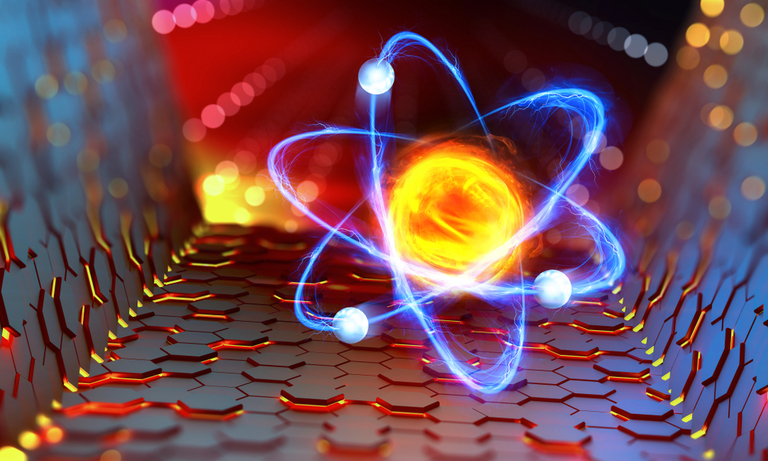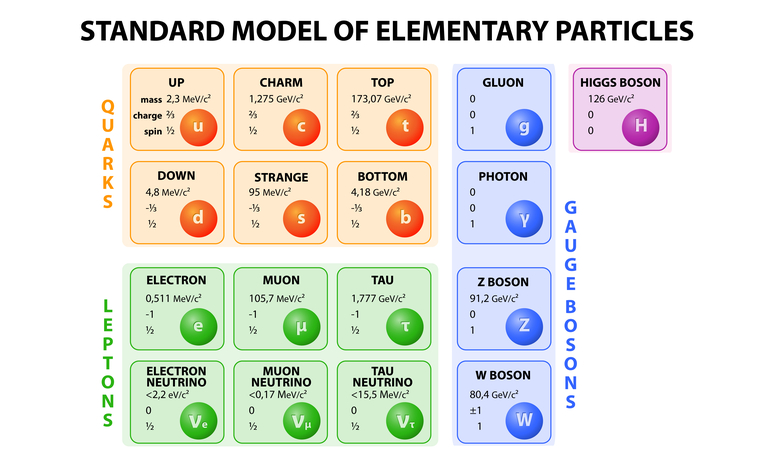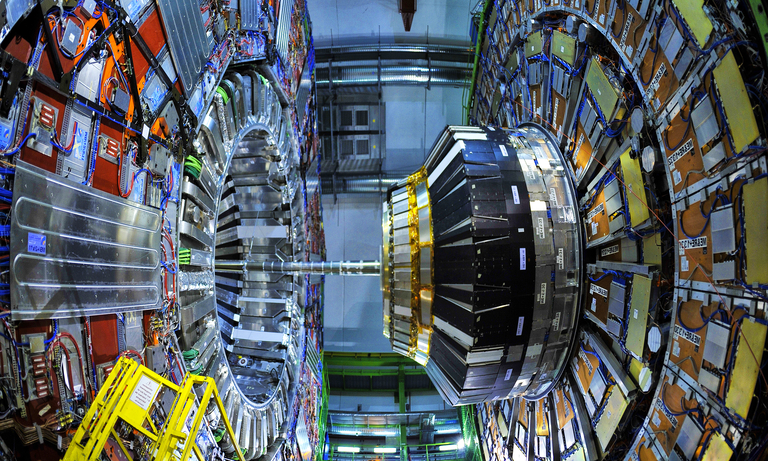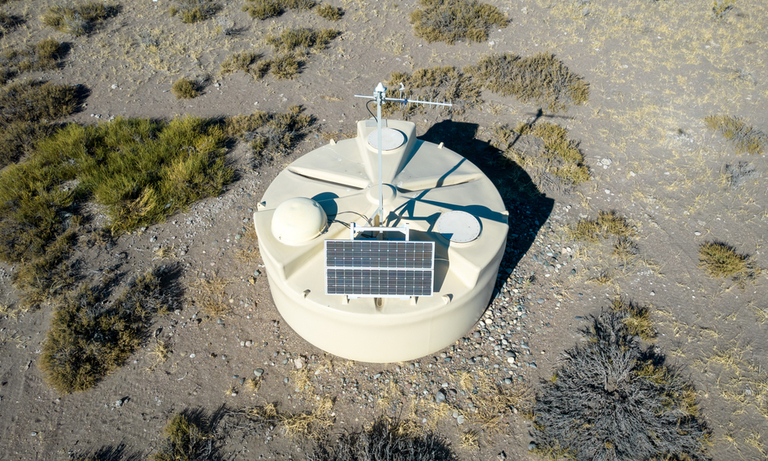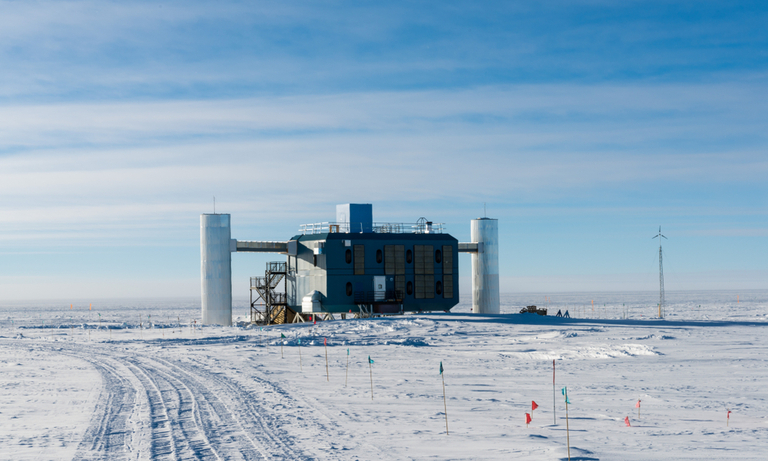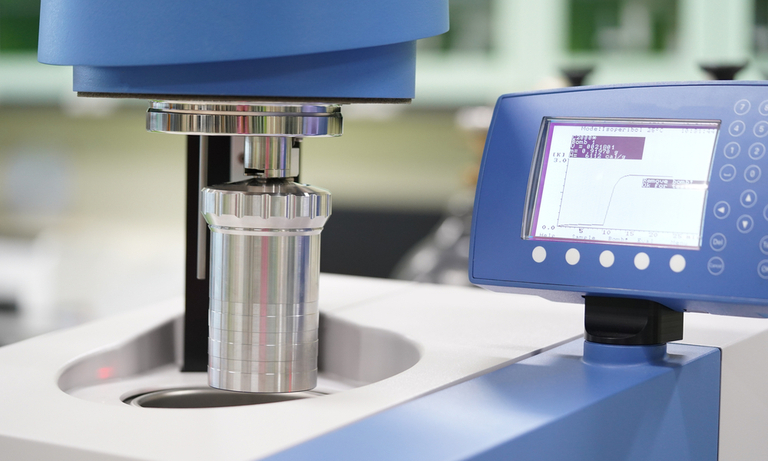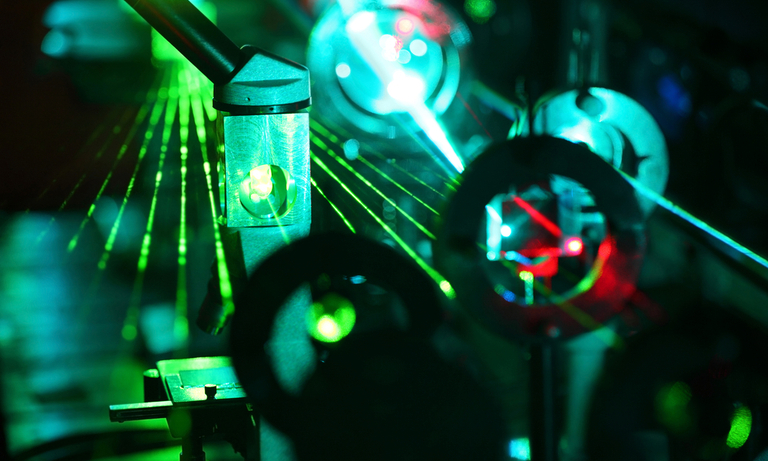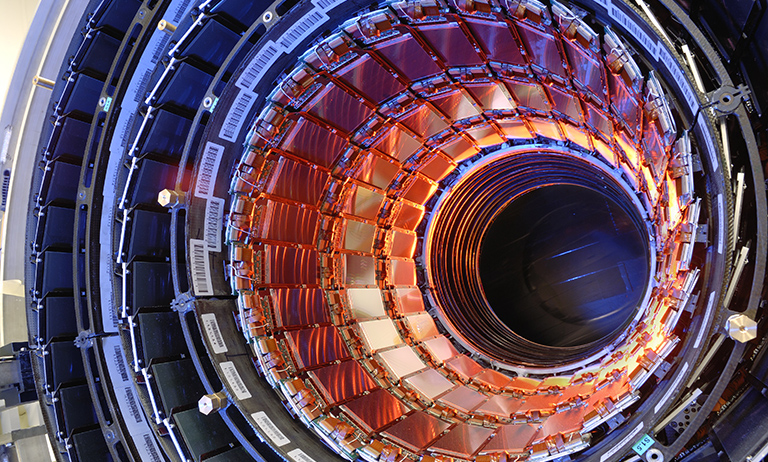Home
Products
Physics Research Field
Type of Experiment
Detector Type
Behind the Science
Tech in a Nutshell
United Kingdom (EN)
Select your region or country.


Liquid Scintillator Tank
Scintillators are transparent materials that exhibit scintillation when charged particles traverse them. A charged particle excites the molecules of the material which, when dis-exciting, produce photons in a number proportional to the energy of the incident radiation. The light is converted into electric current coupling the scintillator with an electronic light sensor such as a photomultiplier tube (PMT), photodiode, or silicon photomultiplier.
Reading the output of such a device it is possible to measure the energy of the incident radiation.
Electronic light sensors are characterized are characterized by fast time response, high detection efficiency and a wide choice of material exist, since both inorganic and organic can be used as scintillators.
Inorganic scintillators have excellent energy conversion efficiency, but unfortunately are not easy to handle because of deliquescence, vulnerability to shock and impact.
Organic scintillators include plastic scintillators and liquid scintillators. They display a short decay time and have no deliquescence. Furthermore plastic scintillators are easy to cut and shape, and easy to handle.
Thanks to these properties they have a wide range of applications, such as medical imaging, e.g. PET (Positron Emission Tomography), oil exploration, monitoring of nuclear power stations, and of course particle physics.
A detector set-up, mainly used to detect neutrinos, consists of a tank filled with a liquid scintillator. Indeed the first detection of this particle by Frederick Reines and Clyde Cowan in 1956, was possible using a solution of liquid scintillator and gadolinium in water.
Modern experiments which are using this kind of detector technique are: Kamioka Liquid-scintillator Anti-Neutrino Detector (KamLAND) in Japan, Daya Bay Reactor Neutrino Experiment in China, Double Chooz in France and the Reactor Experiment for Neutrino Oscillation (RENO) in South Korea.
Experiments of this type detect the anti-neutrino coming from nuclear reactors looking for particles produced through the inverse beta decay (IBD). IBD is a nuclear reaction involving electron anti-neutrino scattering of a proton, creating a positron and a neutron. To also detect the neutron, usually the liquid scintillator is doped with gadolinium which has a high neutron capture cross-section. Their main goal is to study the important phenomenon of the neutrino transition from one flavor to another.
KamLAND is situated in the old Kamiokande cavity in a horizontal mine drift in the Japanese Alps. The experiment consists of an 18 m diameter stainless steel spherical vessel with 1879 Hamamatsu PMTs (type R7250), with 20” diameter and fast time response mounted on the inner surface. Inside the sphere is a 13 m diameter nylon balloon filled with liquid scintillator.
On the outside, non-scintillating, highly purified oil provides buoyancy for the balloon and shields it from external radiation. The stainless steel vessel is surrounded by a water Cherenkov detector, which allows it to reject any external background. The anti-neutrinos are produced through the beta decay of the radioactive elements present in the core of 53 Japanese commercial power reactors around the site at distance of about 180 km.
Daya Bay is situated at approximately 52 kilometers northeast of Hong Kong. The experiment consists of eight anti-neutrino detectors, clustered in three locations within 1.9 km of six nuclear reactors. Each detector consists of 20 t of liquid scintillator doped with gadolinium serving as the target for the inverse beta decay reaction.
The target is surrounded by the so called “gamma catcher” and is filled with 20 t of undoped liquid scintillator for detecting gamma-rays that escape the target volume. The outer volume contains 37 t of mineral oil which shields the inner volumes against radiation from the detector components. There are 192 Hamamatsu 20 cm R5912 oil-proof PMTs assemblies installed in the outer volume and around the circumference of the stainless steel vessel. The top and the bottom surfaces are not instrumented with PMTs; instead, there are two highly reflective panels. The detectors are submerged in a water pool that provides at least 2.5 m of water to degrade radiation from the rock.
The water pool is optically divided into the inner and outer regions, both equipped with Hamamatsu 20 cm R5912 oil-proof PMTs assemblies to serve as water Cherenkov detectors. On the top of the water pool, there are Resistive Plate Chambers serving as another muon detector.
Double Chooz uses reactors of the Chooz Nuclear Power Plant in France as neutrino source and a set of two detectors situated 400 meters and 1050 meters from the reactors which are filled with liquid scintillator doped with gadolinium. The detectors are composed of a set of concentric cylinders. The innermost volume contains 8.3 tons of liquid scintillator doped with gadolinium inside a transparent acrylic vessel, where the neutrinos interact. This part is surrounded by another acrylic vessel, filled with unloaded scintillator, which is in turn surrounded by a buffer tank filled with mineral oil. The buffer acts as a shield against the radioactivity of the detectors surrounding the most inner part.
The inner volume contains 390 Hamamatsu 25 cm R5912 oil-proof PMTs assemblies and is surrounded again by a volume filled with liquid scintillators, that helps to reject the background coming from outside the detectors equipped with 78 Hamamatsu 20 cm R1408. These last two parts are in turn surrounded by 1 m of water in the nearest detector and 15 cm of steel in the other one. The upper part of the detector is covered by plastic scintillator strips grouped into modules which serves as a veto for muons from cosmic-ray.
RENO is located near the Hanbit nuclear power plant in Yongg-wang, in the southwest coast region of South Korea. The plant consists of six reactors linearly aligned with equal distance of about 260 m. One detector is located at 294 m from the center of the six reactors, while another detector is located at 1383 m. Each detector consists of four layers of nested cylindrical structures and contains different liquids. A main inner detector (ID) is contained in a cylindrical stainless steel vessel of 5.4 m in diameter and 5.8 m in height which houses two nested cylindrical acrylic vessels.
Double Chooz uses reactors of the Chooz Nuclear Power Plant in France as neutrino source and a set of two detectors situated 400 meters and 1050 meters from the reactors which are filled with liquid scintillator doped with gadolinium. The detectors are composed of a set of concentric cylinders. The innermost volume contains 8.3 tons of liquid scintillator doped with gadolinium inside a transparent acrylic vessel, where the neutrinos interact. This part is surrounded by another acrylic vessel, filled with unloaded scintillator, which is in turn surrounded by a buffer tank filled with mineral oil. The buffer acts as a shield against the radioactivity of the detectors surrounding the most inner part.
The inner volume contains 390 Hamamatsu 25 cm R5912 oil-proof PMTs assemblies and is surrounded again by a volume filled with liquid scintillators, that helps to reject the background coming from outside the detectors equipped with 78 Hamamatsu 20 cm R1408. These last two parts are in turn surrounded by 1 m of water in the nearest detector and 15 cm of steel in the other one. The upper part of the detector is covered by plastic scintillator strips grouped into modules which serves as a veto for muons from cosmic-ray.
RENO is located near the Hanbit nuclear power plant in Yongg-wang, in the southwest coast region of South Korea. The plant consists of six reactors linearly aligned with equal distance of about 260 m. One detector is located at 294 m from the center of the six reactors, while another detector is located at 1383 m. Each detector consists of four layers of nested cylindrical structures and contains different liquids. A main inner detector (ID) is contained in a cylindrical stainless steel vessel of 5.4 m in diameter and 5.8 m in height which houses two nested cylindrical acrylic vessels.
- Confirmation
-
It looks like you're in the . If this is not your location, please select the correct region or country below.
You're headed to Hamamatsu Photonics website for GB (English). If you want to view an other country's site, the optimized information will be provided by selecting options below.
In order to use this website comfortably, we use cookies. For cookie details please see our cookie policy.
- Cookie Policy
-
This website or its third-party tools use cookies, which are necessary to its functioning and required to achieve the purposes illustrated in this cookie policy. By closing the cookie warning banner, scrolling the page, clicking a link or continuing to browse otherwise, you agree to the use of cookies.
Hamamatsu uses cookies in order to enhance your experience on our website and ensure that our website functions.
You can visit this page at any time to learn more about cookies, get the most up to date information on how we use cookies and manage your cookie settings. We will not use cookies for any purpose other than the ones stated, but please note that we reserve the right to update our cookies.
1. What are cookies?
For modern websites to work according to visitor’s expectations, they need to collect certain basic information about visitors. To do this, a site will create small text files which are placed on visitor’s devices (computer or mobile) - these files are known as cookies when you access a website. Cookies are used in order to make websites function and work efficiently. Cookies are uniquely assigned to each visitor and can only be read by a web server in the domain that issued the cookie to the visitor. Cookies cannot be used to run programs or deliver viruses to a visitor’s device.
Cookies do various jobs which make the visitor’s experience of the internet much smoother and more interactive. For instance, cookies are used to remember the visitor’s preferences on sites they visit often, to remember language preference and to help navigate between pages more efficiently. Much, though not all, of the data collected is anonymous, though some of it is designed to detect browsing patterns and approximate geographical location to improve the visitor experience.
Certain type of cookies may require the data subject’s consent before storing them on the computer.
2. What are the different types of cookies?
This website uses two types of cookies:
- First party cookies. For our website, the first party cookies are controlled and maintained by Hamamatsu. No other parties have access to these cookies.
- Third party cookies. These cookies are implemented by organizations outside Hamamatsu. We do not have access to the data in these cookies, but we use these cookies to improve the overall website experience.
3. How do we use cookies?
This website uses cookies for following purposes:
- Certain cookies are necessary for our website to function. These are strictly necessary cookies and are required to enable website access, support navigation or provide relevant content. These cookies direct you to the correct region or country, and support security and ecommerce. Strictly necessary cookies also enforce your privacy preferences. Without these strictly necessary cookies, much of our website will not function.
- Analytics cookies are used to track website usage. This data enables us to improve our website usability, performance and website administration. In our analytics cookies, we do not store any personal identifying information.
- Functionality cookies. These are used to recognize you when you return to our website. This enables us to personalize our content for you, greet you by name and remember your preferences (for example, your choice of language or region).
- These cookies record your visit to our website, the pages you have visited and the links you have followed. We will use this information to make our website and the advertising displayed on it more relevant to your interests. We may also share this information with third parties for this purpose.
Cookies help us help you. Through the use of cookies, we learn what is important to our visitors and we develop and enhance website content and functionality to support your experience. Much of our website can be accessed if cookies are disabled, however certain website functions may not work. And, we believe your current and future visits will be enhanced if cookies are enabled.
4. Which cookies do we use?
There are two ways to manage cookie preferences.
- You can set your cookie preferences on your device or in your browser.
- You can set your cookie preferences at the website level.
If you don’t want to receive cookies, you can modify your browser so that it notifies you when cookies are sent to it or you can refuse cookies altogether. You can also delete cookies that have already been set.
If you wish to restrict or block web browser cookies which are set on your device then you can do this through your browser settings; the Help function within your browser should tell you how. Alternatively, you may wish to visit www.aboutcookies.org, which contains comprehensive information on how to do this on a wide variety of desktop browsers.
5. What are Internet tags and how do we use them with cookies?
Occasionally, we may use internet tags (also known as action tags, single-pixel GIFs, clear GIFs, invisible GIFs and 1-by-1 GIFs) at this site and may deploy these tags/cookies through a third-party advertising partner or a web analytical service partner which may be located and store the respective information (including your IP-address) in a foreign country. These tags/cookies are placed on both online advertisements that bring users to this site and on different pages of this site. We use this technology to measure the visitors' responses to our sites and the effectiveness of our advertising campaigns (including how many times a page is opened and which information is consulted) as well as to evaluate your use of this website. The third-party partner or the web analytical service partner may be able to collect data about visitors to our and other sites because of these internet tags/cookies, may compose reports regarding the website’s activity for us and may provide further services which are related to the use of the website and the internet. They may provide such information to other parties if there is a legal requirement that they do so, or if they hire the other parties to process information on their behalf.
If you would like more information about web tags and cookies associated with on-line advertising or to opt-out of third-party collection of this information, please visit the Network Advertising Initiative website http://www.networkadvertising.org.
6. Analytics and Advertisement Cookies
We use third-party cookies (such as Google Analytics) to track visitors on our website, to get reports about how visitors use the website and to inform, optimize and serve ads based on someone's past visits to our website.
You may opt-out of Google Analytics cookies by the websites provided by Google:
https://tools.google.com/dlpage/gaoptout?hl=en
As provided in this Privacy Policy (Article 5), you can learn more about opt-out cookies by the website provided by Network Advertising Initiative:
http://www.networkadvertising.org
We inform you that in such case you will not be able to wholly use all functions of our website.
Close



